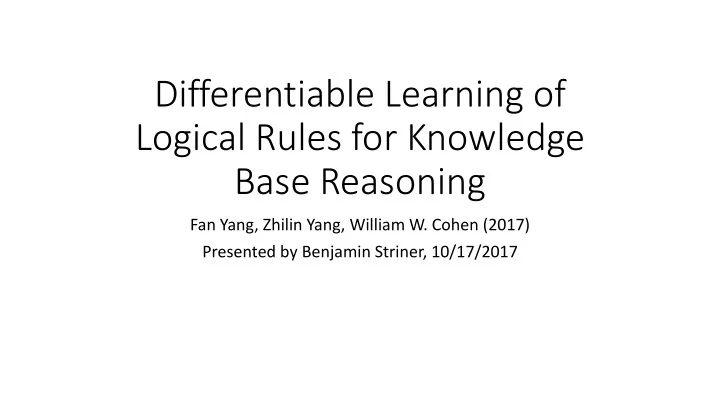

Differentiable Learning of Logical Rules for Knowledge Base Reasoning Fan Yang, Zhilin Yang, William W. Cohen (2017) Presented by Benjamin Striner, 10/17/2017
Contents • Why logic? • Tasks and datasets • Model • Results
Why Logical Rules? • Logical rules have the potential to generalize well • Logical rules are explainable and understandable • Train and test entities do not need to overlap
Learning logical rules • Goal is to learn logical rules (simple inference rules) • Each rule has a confidence (alpha)
Dataset and Tasks
Tasks • Knowledge base completion • Grid path finding • Question answering
Knowledge Base Completion • Training knowledge base is missing edges • Predict the missing relationships
Knowledge Base Completion Datasets • Wordnet • Freebase • Unified Medical Language System (UMLS) • Kinship: relationships among a tribe
Grid path finding • Generate 16x16 grid, relationships are directions • Allows large but simple dataset • Evaluated similarly to KBC
Question answering • KB contains tuples of movie information • Answer natural language (but simple) questions
Model
TensorLog • Matrix multiplication can be used for simple logic • E are entities • Encoded as one-hot vector v • R are relationships • Encoded as adjacency matrix M • P(Y,Z)^Q(Z,X) = Mp*Mq*vx
Learning a rule • Rule is a product over relationship matrices • Each rule has a confidence (alpha) • L indexes over all rules • Objective is to select rule that results in best score • Many possible rules
Differentiable rules • Exchange product and sum • Now learning a single rule, each step is combination of relationships
Attention and recurrence • Attention over previous memories “memory attention vector” (b) • Attention over relationship matrices “operator attention vector” (a) • Controller (next slide) determines attention
Controller • Recurrent controller produces attention vectors • Input is query (END token when t=T+1) • Query is embedded in continuous space • LSTM used for recurrence
Objective • Maximize • (Relationships and entities are positive) • No max-margin, negative sampling, etc.
Recovering logical rules
Results
KBC Results • Outperforms previous work
Details • FB15KSelected is harder because it removes inverse relationships • Augment by adding all inverse relationships • Many possible relationships • Restrict to top 128 relationships that have entities in common with query • Maximum rule length is 2 for all datasets
Additional KBC results • Performance on UMLS and Kinship
Grid Path Finding results
QA Results
QA implementation details • Identify tail word as the word that is in the database • Query is mean of embeddings of words • Limit to 6 word queries and only top 100 most frequent words
Questions/Discussion
Recommend
More recommend